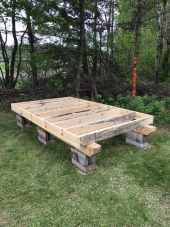Hi, Permies Family
It was the smell that hit me first. That sharp, eye-watering sting of ammonia that clings to the back of your throat. I remember my first winter as a chicken keeper. I’d spent weeks building what I thought was the perfect, cozy fortress for my small flock of Buff Orpingtons. I sealed every crack, insulated the walls, and made sure it was snug and tight against the coming cold. I was proud. My girls would be the warmest, safest chickens in the county.
But a few weeks into the first cold snap, I noticed things were… off. The air in the coop was thick and heavy. Condensation dripped down the inside of the windows, even when it wasn’t raining. My friendliest hen, a beautiful bird named Goldie, seemed listless and had started sneezing.
I walked in one morning to that overwhelming ammonia smell and saw it: the tips of my rooster’s magnificent comb were turning a dark, waxy black. Frostbite.
In my effort to keep my chickens warm, I had nearly made them sick. I had created a toxic, stagnant box by completely ignoring the single most important element of a healthy coop: ventilation.
It’s a mistake almost every new chicken keeper makes. We think of ventilation as something for summer, to keep things cool. We hear the word "draft" and immediately think it’s the enemy of a winter coop. But the truth is, proper, year-round ventilation is the invisible guardian of your flock’s health. It’s the difference between a vibrant, thriving flock and one plagued by respiratory illness, frostbite, and lethargy.
So, let's demystify coop ventilation. How much do you
really need, and how do you get it right without turning your coop into a wind tunnel?
The Two Silent Villains: Ammonia and Moisture
To understand why ventilation is so critical, you need to understand the two enemies it defeats: ammonia and moisture.
Ammonia: The Invisible Threat That pungent smell is more than just unpleasant; it's a sign of a serious health hazard. Chicken droppings release ammonia gas, a toxic substance that is lighter than air and naturally rises. When you can smell ammonia, it means the concentration is already at a level that can cause respiratory damage to your birds. Levels as low as 25 parts per million (ppm) can lead to eye irritation, damage to the respiratory system, and increased susceptibility to diseases.
The scary part? You can become desensitized to the smell, a phenomenon called olfactory fatigue. This means you might not notice dangerous levels are building up, but your chickens, living low to the ground, are breathing it in constantly. This is why you can never have a "safe" level of ammonia smell in your coop.
Moisture: The Frostbite Enabler A single chicken can release a surprising amount of moisture into the air just by breathing and pooping. In a sealed coop, this moisture has nowhere to go. It condenses on cold surfaces, making the bedding damp and the air humid.
In the summer, high humidity makes it harder for chickens to cool themselves down, increasing the risk of heat stress. But in the winter, moisture is even more dangerous. It’s the primary cause of frostbite. A damp environment makes it impossible for a chicken’s feathers to provide proper insulation. The moisture in the air can freeze directly onto their combs and wattles, causing the tissue to die. If you see frost on the inside of your coop windows, it's a major red flag that you have a moisture problem and need more ventilation immediately.
Proper ventilation works year-round to continuously exhaust this warm, moist, ammonia-laden air and replace it with fresh, clean air.
The Golden Rule: Ventilation vs. Drafts
This is the concept that trips up most chicken keepers. We need to get stale air out and fresh air in, but we must do it without creating a cold draft that blows directly on our roosting birds.
So, what’s the difference?
[] Ventilation is the gentle, continuous exchange of air, happening above your chickens' heads.
[] A Draft is a direct, chilling breeze blowing on your chickens, ruffling their feathers and robbing them of their natural insulation.
The solution is simple:
vents go high, pop doors stay low.
By placing your vents at the highest points of the coop—in the gables, along the roofline, or as a ridge vent—you take advantage of basic physics. The warm, humid, ammonia-filled air rises and exits through these high vents. Cooler, fresh air can then enter through lower openings (like the pop door or lower vents) to create a slow, steady circulation pattern that doesn't chill the birds on their roosts. This is often called the "stack effect" and it's the key to passive, draft-free ventilation.
How Much is Enough? A Practical Guide
You'll see a lot of formulas out there, like 1 square foot of ventilation per 10 square feet of floor space, or even 1 square foot per bird. While these are good starting points, the reality is that your needs will vary based on your climate, coop size, and flock density.
Here’s a more practical, season-by-season approach:
Winter Ventilation: The Non-Negotiable Minimum
In winter, your goal is to remove moisture and ammonia without losing too much heat. You should have permanent, year-round vents that cannot be fully closed. These should be located high up, well above the roosts.
What to do:
[] High Vents are Essential: Install vents in the gables at either end of the coop or create a gap along the top of the walls where they meet the roof (protected by eaves). This creates cross-ventilation high up, which is crucial.
[] Keep Them Open: These high vents should remain open 24/7, 365 days a year. You can partially block them during the most brutal storms, but never seal them completely.
[*] Avoid Drafts: Ensure there are no openings at roosting height that could allow a cold wind to blow directly on your flock. Windows should be closed tightly at night.
A common mistake is thinking a sealed coop is a warm coop. In reality, a dry, well-ventilated coop is much warmer and safer for your chickens than a damp, sealed one. A dry bird can easily handle the cold; a damp bird cannot. For more tips on getting your coop ready for the cold, check out this comprehensive
guide to winterizing your chicken coop.
Summer Ventilation: The More, The Merrier
In summer, heat is the main enemy. Your goal is to create as much airflow as possible to help your flock stay cool.
What to do:
[] Open Everything Up: This is the time to open all those windows and extra vents. Creating cross-ventilation at multiple levels is key.
[] Use Large Openings: If your coop opens into a secure, predator-proof run, consider replacing the main door with a screen door or leaving the top half of a Dutch door open.
[*] Consider a Fan: For very hot climates or larger coops, a fan can be a lifesaver. Place it securely outside an opening, pointing out, to pull hot air from the coop. Never place it inside where birds can be injured.
Managing summer heat is critical. If you're looking for more ways to help your flock beat the heat, you might find this article on
what to feed chickens during a heatwave very helpful.
Putting It All Together: A Simple Ventilation Plan
Don't overcomplicate it. A great ventilation system can be built into any coop, big or small.
Install High, Permanent Vents: Cut vents into the gables or leave a gap under the eaves. Cover all openings with 1/2-inch hardware cloth to ensure you are
predator-proofing your coop. These are your year-round workhorses.
Add Low, Adjustable Openings: Install windows or low vents that can be opened in the summer for maximum airflow and closed securely in the winter.
Observe Your Coop: Your coop will tell you what it needs. Is there condensation on the windows? You need more ventilation. Does it smell like ammonia? You need more ventilation. Are your chickens huddled in one corner? You might have a draft. Watch your birds' behavior—if they are panting or holding their wings away from their bodies, they are too hot.
After my initial failure, I went back to my "fortress" with a saw. I cut large, hardware-cloth-covered vents high up in the gables on both ends. The change was almost immediate. The air cleared, the condensation vanished, and Goldie’s sneezing stopped. My rooster’s comb healed, and the flock was visibly happier and more active.
It was a powerful lesson: sometimes the best way to care for our chickens is to give them what they need, not what we
think they need. And more than anything, they need fresh air. So go out there, take a deep breath inside your coop, and don't be afraid to cut a few more holes. Your flock will thank you for it.

 6
6




 2
2




 2
2









